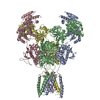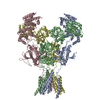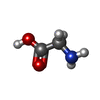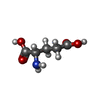[English] 日本語
 Yorodumi
Yorodumi- PDB-9bib: Rat GluN1-GluN2B NMDA receptor channel in complex with glycine, g... -
+ Open data
Open data
- Basic information
Basic information
| Entry | Database: PDB / ID: 9bib | |||||||||
|---|---|---|---|---|---|---|---|---|---|---|
| Title | Rat GluN1-GluN2B NMDA receptor channel in complex with glycine, glutamate, and EU-1622-A, in open-channel conformation, C1 symmetry | |||||||||
 Components Components |
| |||||||||
 Keywords Keywords | MEMBRANE PROTEIN / Ionotropic glutamate receptor / synaptic membrane protein | |||||||||
| Function / homology |  Function and homology information Function and homology informationpons maturation / positive regulation of Schwann cell migration / regulation of cell communication / EPHB-mediated forward signaling / Assembly and cell surface presentation of NMDA receptors / olfactory learning / conditioned taste aversion / dendritic branch / regulation of respiratory gaseous exchange / protein localization to postsynaptic membrane ...pons maturation / positive regulation of Schwann cell migration / regulation of cell communication / EPHB-mediated forward signaling / Assembly and cell surface presentation of NMDA receptors / olfactory learning / conditioned taste aversion / dendritic branch / regulation of respiratory gaseous exchange / protein localization to postsynaptic membrane / transmitter-gated monoatomic ion channel activity / response to glycine / propylene metabolic process / Synaptic adhesion-like molecules / regulation of monoatomic cation transmembrane transport / NMDA glutamate receptor activity / RAF/MAP kinase cascade / voltage-gated monoatomic cation channel activity / neurotransmitter receptor complex / NMDA selective glutamate receptor complex / ligand-gated sodium channel activity / response to morphine / calcium ion transmembrane import into cytosol / glutamate binding / regulation of axonogenesis / neuromuscular process / regulation of dendrite morphogenesis / protein heterotetramerization / regulation of synapse assembly / male mating behavior / glycine binding / positive regulation of reactive oxygen species biosynthetic process / parallel fiber to Purkinje cell synapse / positive regulation of calcium ion transport into cytosol / suckling behavior / response to amine / startle response / social behavior / monoatomic cation transmembrane transport / associative learning / regulation of neuronal synaptic plasticity / cellular response to glycine / monoatomic cation transport / excitatory synapse / positive regulation of excitatory postsynaptic potential / positive regulation of dendritic spine maintenance / monoatomic ion channel complex / Unblocking of NMDA receptors, glutamate binding and activation / long-term memory / cellular response to manganese ion / glutamate receptor binding / synaptic cleft / prepulse inhibition / phosphatase binding / monoatomic cation channel activity / glutamate-gated receptor activity / calcium ion homeostasis / response to fungicide / regulation of neuron apoptotic process / presynaptic active zone membrane / glutamate-gated calcium ion channel activity / ligand-gated monoatomic ion channel activity involved in regulation of presynaptic membrane potential / dendrite membrane / sensory perception of pain / sodium ion transmembrane transport / response to amphetamine / ionotropic glutamate receptor signaling pathway / positive regulation of synaptic transmission, glutamatergic / hippocampal mossy fiber to CA3 synapse / adult locomotory behavior / learning / regulation of membrane potential / excitatory postsynaptic potential / transmitter-gated monoatomic ion channel activity involved in regulation of postsynaptic membrane potential / synaptic transmission, glutamatergic / regulation of long-term neuronal synaptic plasticity / synaptic membrane / postsynaptic density membrane / terminal bouton / : / visual learning / cerebral cortex development / calcium ion transmembrane transport / regulation of synaptic plasticity / calcium channel activity / memory / neuron cellular homeostasis / intracellular calcium ion homeostasis / synaptic vesicle membrane / response to calcium ion / calcium ion transport / rhythmic process / synaptic vesicle / signaling receptor activity / amyloid-beta binding / presynaptic membrane / protein-containing complex assembly / chemical synaptic transmission / dendritic spine / negative regulation of neuron apoptotic process Similarity search - Function | |||||||||
| Biological species |  | |||||||||
| Method | ELECTRON MICROSCOPY / single particle reconstruction / cryo EM / Resolution: 3.81 Å | |||||||||
 Authors Authors | Chou, T.-H. / Furukawa, H. | |||||||||
| Funding support |  United States, 2items United States, 2items
| |||||||||
 Citation Citation |  Journal: Nature / Year: 2024 Journal: Nature / Year: 2024Title: Molecular mechanism of ligand gating and opening of NMDA receptor. Authors: Tsung-Han Chou / Max Epstein / Russell G Fritzemeier / Nicholas S Akins / Srinu Paladugu / Elijah Z Ullman / Dennis C Liotta / Stephen F Traynelis / Hiro Furukawa /  Abstract: Glutamate transmission and activation of ionotropic glutamate receptors are the fundamental means by which neurons control their excitability and neuroplasticity. The N-methyl-D-aspartate receptor ...Glutamate transmission and activation of ionotropic glutamate receptors are the fundamental means by which neurons control their excitability and neuroplasticity. The N-methyl-D-aspartate receptor (NMDAR) is unique among all ligand-gated channels, requiring two ligands-glutamate and glycine-for activation. These receptors function as heterotetrameric ion channels, with the channel opening dependent on the simultaneous binding of glycine and glutamate to the extracellular ligand-binding domains (LBDs) of the GluN1 and GluN2 subunits, respectively. The exact molecular mechanism for channel gating by the two ligands has been unclear, particularly without structures representing the open channel and apo states. Here we show that the channel gate opening requires tension in the linker connecting the LBD and transmembrane domain (TMD) and rotation of the extracellular domain relative to the TMD. Using electron cryomicroscopy, we captured the structure of the GluN1-GluN2B (GluN1-2B) NMDAR in its open state bound to a positive allosteric modulator. This process rotates and bends the pore-forming helices in GluN1 and GluN2B, altering the symmetry of the TMD channel from pseudofourfold to twofold. Structures of GluN1-2B NMDAR in apo and single-liganded states showed that binding of either glycine or glutamate alone leads to distinct GluN1-2B dimer arrangements but insufficient tension in the LBD-TMD linker for channel opening. This mechanistic framework identifies a key determinant for channel gating and a potential pharmacological strategy for modulating NMDAR activity. | |||||||||
| History |
|
- Structure visualization
Structure visualization
| Structure viewer | Molecule:  Molmil Molmil Jmol/JSmol Jmol/JSmol |
|---|
- Downloads & links
Downloads & links
- Download
Download
| PDBx/mmCIF format |  9bib.cif.gz 9bib.cif.gz | 494.2 KB | Display |  PDBx/mmCIF format PDBx/mmCIF format |
|---|---|---|---|---|
| PDB format |  pdb9bib.ent.gz pdb9bib.ent.gz | 365.5 KB | Display |  PDB format PDB format |
| PDBx/mmJSON format |  9bib.json.gz 9bib.json.gz | Tree view |  PDBx/mmJSON format PDBx/mmJSON format | |
| Others |  Other downloads Other downloads |
-Validation report
| Arichive directory |  https://data.pdbj.org/pub/pdb/validation_reports/bi/9bib https://data.pdbj.org/pub/pdb/validation_reports/bi/9bib ftp://data.pdbj.org/pub/pdb/validation_reports/bi/9bib ftp://data.pdbj.org/pub/pdb/validation_reports/bi/9bib | HTTPS FTP |
|---|
-Related structure data
| Related structure data |  44586MC  9areC  9arfC  9argC  9arhC  9ariC C: citing same article ( M: map data used to model this data |
|---|---|
| Similar structure data | Similarity search - Function & homology  F&H Search F&H Search |
- Links
Links
- Assembly
Assembly
| Deposited unit | 
|
|---|---|
| 1 |
|
- Components
Components
| #1: Protein | Mass: 95225.883 Da / Num. of mol.: 2 Source method: isolated from a genetically manipulated source Source: (gene. exp.)   #2: Protein | Mass: 98888.945 Da / Num. of mol.: 2 Source method: isolated from a genetically manipulated source Source: (gene. exp.)   #3: Chemical | #4: Chemical | Has ligand of interest | Y | Has protein modification | Y | |
|---|
-Experimental details
-Experiment
| Experiment | Method: ELECTRON MICROSCOPY |
|---|---|
| EM experiment | Aggregation state: PARTICLE / 3D reconstruction method: single particle reconstruction |
- Sample preparation
Sample preparation
| Component | Name: Di-heterotetrameric GluN1-GluN2B NMDA receptors / Type: COMPLEX / Entity ID: #1-#2 / Source: RECOMBINANT |
|---|---|
| Molecular weight | Value: 0.4 MDa / Experimental value: NO |
| Source (natural) | Organism:  |
| Source (recombinant) | Organism:  |
| Buffer solution | pH: 7.5 |
| Specimen | Conc.: 4 mg/ml / Embedding applied: NO / Shadowing applied: NO / Staining applied: NO / Vitrification applied: YES |
| Specimen support | Grid material: GOLD / Grid mesh size: 300 divisions/in. / Grid type: UltrAuFoil R1.2/1.3 |
| Vitrification | Cryogen name: ETHANE / Humidity: 85 % / Chamber temperature: 285 K |
- Electron microscopy imaging
Electron microscopy imaging
| Experimental equipment |  Model: Titan Krios / Image courtesy: FEI Company |
|---|---|
| Microscopy | Model: FEI TITAN KRIOS |
| Electron gun | Electron source:  FIELD EMISSION GUN / Accelerating voltage: 300 kV / Illumination mode: FLOOD BEAM FIELD EMISSION GUN / Accelerating voltage: 300 kV / Illumination mode: FLOOD BEAM |
| Electron lens | Mode: BRIGHT FIELD / Nominal defocus max: 2800 nm / Nominal defocus min: 1400 nm |
| Image recording | Electron dose: 66.3 e/Å2 / Film or detector model: GATAN K3 BIOQUANTUM (6k x 4k) |
- Processing
Processing
| EM software |
| ||||||||||||||||||||||||||||||||
|---|---|---|---|---|---|---|---|---|---|---|---|---|---|---|---|---|---|---|---|---|---|---|---|---|---|---|---|---|---|---|---|---|---|
| CTF correction | Type: NONE | ||||||||||||||||||||||||||||||||
| Particle selection | Num. of particles selected: 1426240 | ||||||||||||||||||||||||||||||||
| 3D reconstruction | Resolution: 3.81 Å / Resolution method: FSC 0.143 CUT-OFF / Num. of particles: 293641 / Symmetry type: POINT | ||||||||||||||||||||||||||||||||
| Atomic model building | Protocol: RIGID BODY FIT / Space: REAL | ||||||||||||||||||||||||||||||||
| Atomic model building | PDB-ID: 9ARE Accession code: 9ARE / Source name: PDB / Type: experimental model | ||||||||||||||||||||||||||||||||
| Refine LS restraints |
|
 Movie
Movie Controller
Controller







 PDBj
PDBj









